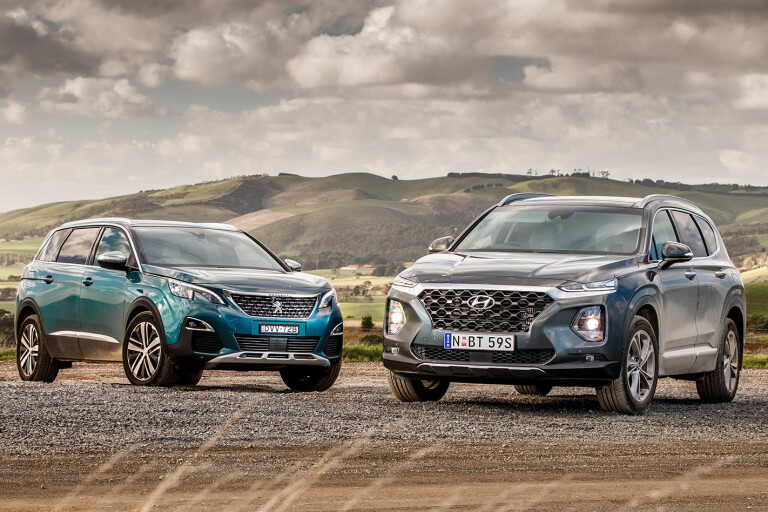
We have already established that the Peugeot 5008 is a commendable seven-seat SUV that sacrifices a little practicality in the name of style, design and to be that bit different, and it deserves recognition for daring to swim against the current of more mainstream boxy SUVs.
There are plenty of white-goods-people haulers in the market, but the pretty Pug offers something for the more aesthetically conscious customer with a unique design inside and out.

On the other hand there is the Hyundai Santa Fe, which has typically represented a more no-frills approach to large SUVs while still offering a good value package of practicality.
But the South Korean brand is realising something of a styling renaissance with SUV models including the Tucson and Kona placing emphasis on looking more memorable, while still upholding Hyundai’s value principles.
Both manufacturers offer entry-level versions powered by petrol engines but we focused on the most premium variants with diesel power under the bonnet.
So we pitched the latest version of the resoundingly popular Santa Fe against the niche favourite 5008 to see if a more style-driven Hyundai can learn a lesson in European design, while still offering the all-rounder package that Aussie buyers have come to expect.
Price and equipment
Peugeot 5008
If you’re trying to stand out as the leftfield manufacturer among conservative company, then nothing says unorthodox quite like an electric scooter stowed in its own boot-mounted charging cradle. The e-Kick electrically assisted scooter is an eye-watering $1700 option that we think will find a very limited audience – perhaps the ‘e’ stands for esoteric, but nicely highlights the French car maker as a free thinker.
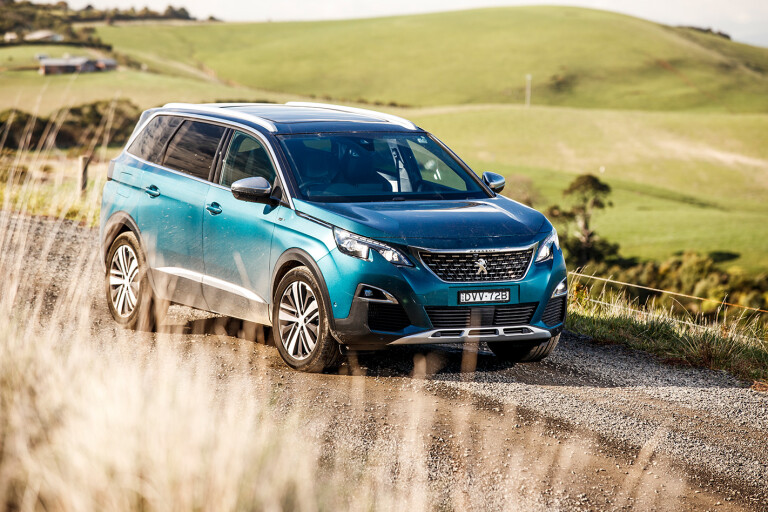
Once the preserve of concept cars, the fold-up conveyance clicks together in seconds and allows up to 12km of zero-emissions scooting for those final few kilometres that the 5008 can’t cover, such as a pedestrianised metropolis for example.
Base price for the 5008 GT is $54,490 and includes two ‘interior ambience’ choices as part of the i-Cockpit, which changes the cabin lighting, dynamics and even the interior fragrance. As the names suggest, Boost imparts a more energetic atmosphere, while Relax uses more serene lighting and a corresponding air freshener scent.
A 12.3-inch digital screen replaces more conventional analogue gauges, viewed over the top of the steering wheel (not through it), complemented by a central 8.0-inch touchscreen.
The driver’s seat gets eight-way electric adjustment, both front seats are heated, the second row gets window blinds and a pair of airline-style tray tables and the third row of seating folds flat or is completely removable for boosted boot space.
A hands-free power tailgate can be operated with a foot swipe under the rear bumper and as the top-spec 5008, 19-inch wheels are standard, as are LED headlights, chrome look door mirrors, wheel-arch extensions and GT badging to complete the exterior looks.

In addition to the legally required safety systems, the 5008 has a 360-degree camera with parking sensors front and rear, autonomous emergency braking, speed sign recognition, lane-keep assistance with blind-spot monitoring and Isofix child seat mountings for two seats. ANCAP is yet to award the 5008 with a safety rating.
For what it’s worth, we could live without the way-over-the-top door-open siren that sounds more like a space station fire evacuation alarm.
Peugeot’s Grip Control is standard for entry Allure and GT Line bringing more all-terrain grip but is a no-cost option for the GT as it adopts the smaller 18-inch wheels.
Beyond its final-kilometre scooter option, the Pug was specced up with a smart Nappa leather interior with quilted pattern (replaces the standard Alcantara and artificial leather), a panoramic sunroof for an extra $4000 and a posh lick of paint for $690.
Hyundai Santa Fe
At $60,500 before on-road costs, the Hyundai Santa Fe Highlander kicks off a little pricier than the Peugeot but packs in more standard kit.
Like the Peugeot, the Hyundai has a central 8.0-inch touchscreen, but the instrument cluster is only partly digital and flanked by more traditional gauges. It does, however, double up with a head-up display.

A hands-free power tailgate is also standard but, unlike the Peugeot, you don’t have to pay extra for the panoramic sunroof or leather – albeit only part-leather in the Hyundai.
The Hyundai also trumps the Peugeot with 10-way driver’s seat adjustment and eight-way adjustment for the passenger too. Both front seats have heating, with cooling ventilation as well, and the second-row seating and steering wheel also get heaters.
If heated seats are a must in the Santa Fe then the Highlander range-topper is now your only choice, with the previous-gen Elite heated seats now relegated, to the displeasure of some existing customers.
Second-row occupants do not get their own climate control panel, but there is a basic controller for the third row, while all passengers benefit from an air ioniser incorporated into the dual-zone climate control.

Safety highlights match the Peugeot almost exactly, though the Hyundai is also yet to be awarded an ANCAP rating.
Winner: Santa Fe
Interior and connectivity
Peugeot 5008
A majority of the Peugeot’s fans will doubtless be drawn to the excellent exterior styling, but the European flair continues through to the cabin as well with an unorthodox layout that loses little practicality by being stylish.
Peering over the top of the steering wheel (negating the need for head-up display, says Peugeot) and a tachometer that counters the clockwise rotation of the speedo takes some getting used to but otherwise, the design is intuitive and ergonomic.

We particularly like the easy-to-use but pretty switchgear, ambient lighting that emanates even from the sunroof frame and the use of top quality and unusual materials throughout.
Annoyingly, some switches seem to be a little ignorant and need a prolonged or repeated push to get them to obey including the start/stop button, gear selector, rear wiper and even the horn.
While the second row has limited headroom, it is comfortable and well-appointed with sliding bench and adjustable back rest, the third row of seating is not such a viable proposition for adults or really anyone other than small children. With two extra seats, the 5008 is certainly a seven-seater by definition but relatively small dimensions for a three-row SUV seriously limit its practicality as a people mover.
If our car wasn’t fitted with the optional panoramic roof, we suspect front seat headroom would be severely limited as well.
Compared with the Hyundai, the Peugeot is 59mm shorter, 36mm narrower and has 44mm less height and that translates to a smaller cabin in every dimension except its boot. 780 litres compares with 547L for the Hyundai. Those figures expand to 1940L and 1625 respectively with the second-row seats folded away.
Charging devices and keeping a small fridge powered for example will not be a problem in the Peugeot with three 12-volt sockets scattered about the 5008 cabin, a pair of USB sockets for the second row and two more up front.

Navigation, Apple CarPlay and Android Auto mirroring is standard, along with wireless device charging in the front, digital radio and Bluetooth connectivity.
Hyundai Santa Fe
There was nothing really wrong with the cabin of the previous-generation Santa Fe but nor was there anything particularly memorable about it either. For this version however, the South Korean car maker has made major changes and the result is a huge step forward in design and ergonomics.
What appear to be limited to frivolous styling touches in the form of segmented dash, door and seat panelling actually turn out to be ergonomically excellent additions to the cabin and the layout is well thought through. A random angular pattern to the speaker covers, seats and dash insert bring a more contemporary look along with unusual materials such as the almost tweed-like roof lining.

With its more generous exterior dimensions, the Santa Fe is somewhat of a second-row champion in the segment with ample space and great comfort features including seat heaters, sun blinds and two USB ports.
But the good news continues into the third row where the pair of seats can realistically accommodate adults for shorter journeys. They are also easy to access thanks to an electrically sliding second row.
Technology features well too with an almost identical kit list as the Peugeot including Android Auto/Apple CarPlay, navigation, Bluetooth and digital radio, but ups the audio ante with a ten-speaker stereo courtesy of Infinity.
Winner: Santa Fe
Ride and handling
Peugeot 5008
With a kerb weight of 1631kg, the 5008 is somewhat of a lightweight in the segment and that translates to a nature that driving enthusiasts will appreciate. There’s a real confidence to the front end grip and body-roll is minimal even when being fed through corners fast.
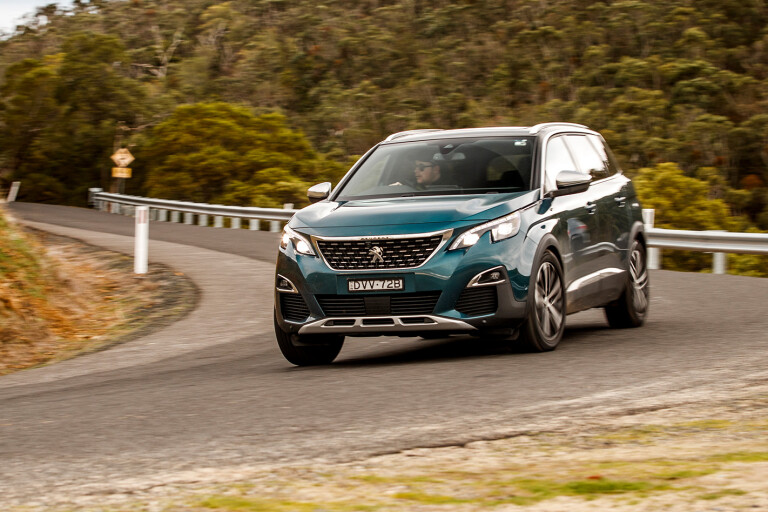
The low weight also helps the 5008 to recover well from mid-corner bumps and its more car-like height keeps the centre of gravity low for a confident stance when carrying pace.
In Sport mode the extra steering weight combines with the dinky steering wheel for a genuinely involved drive if a little synthetic in feel.
Decent dynamics come at the cost of a firmer ride, but it’s not distracting and the lower ride height reduces the ‘head toss’ of some large SUVs that sit higher above the road. Another cost will almost certainly be all-terrain ability, particularly as the Peugeot is not available with four-wheel drive. However, it is unlikely any 5008 owner would consider fording anything much more serious than a small creek or venturing far on unsealed roads, which the Peugeot will handle just fine.
Hyundai Santa Fe
You might expect the relatively large and heavy Hyundai to languish behind the Peugeot’s light-footed road manner, but it has another surprise up its sleeve here too.
It may be close to two tonnes, but the big Hyundai hides its weight admirably in corners and has an obedient front end with surprisingly sharp turn-in. Retracing some of the roads covered in the Peugeot, we found ourselves carrying more speed in the Hyundai such was its dynamic stability and confidence.
Only its brakes, which required a really good push to start scrubbing pace effectively, hinted at the significant mass. Otherwise, the Santa Fe’s dynamics have significantly grown up for the new generation.
When cruising, the Hyundai’s manners are as sophisticated as the previous-generation model and, although its loftier ride height prompts more head-toss than the Peugeot, it is the more cosseting of the cruisers.
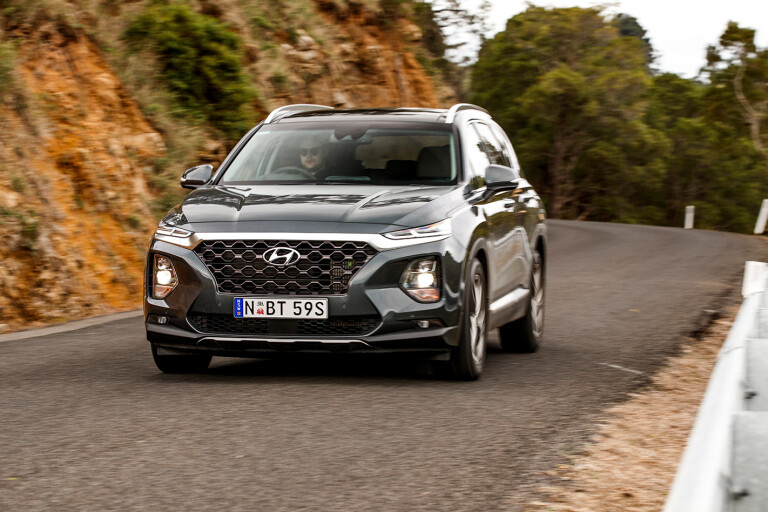
That extra altitude also adds to a more commanding position on the road with excellent visibility and allows confident control of its large proportions.
Our only qualm with the steering would be the irritating lane-departure assistance that nibbles annoyingly at the steering long before the wheels threaten to wander outside of a lane. The function can be switched off, but it defaults back on whenever the ignition is switched off.
Winner: A tie
Performance and economy
Peugeot 5008
The Peugeot is equipped with a 2.0-litre four-cylinder turbocharged diesel producing 133kW and 400Nm and while that’s not the most powerful in the segment, the bantam 5008 is one of the lightest at 1575kg.
As a front-wheel drive, the smaller French offering is around 300kg lighter than the Hyundai, which has an obvious impact on comparative fuel economy. Peugeot states the official combined consumption as 4.8L/100km, but over varied driving styles we managed to use an average of 7.8L/100km.
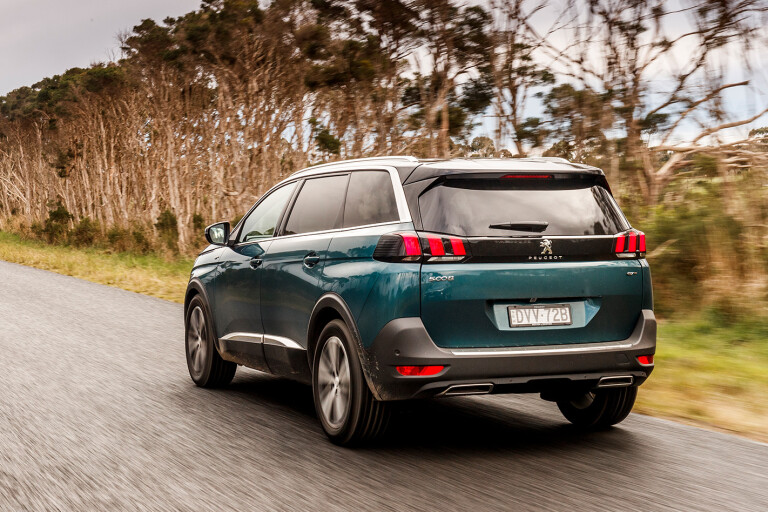
Idle stop/start technology helps to increase range, but can be late to restart and prompted us to reach for the cancel button when approaching busy roundabouts. Combined with a little transmission and turbo lag, the Pug can feel a little lethargic off the line.
Once up to speed though, the refined engine punches on adequately and even sounds good when the driving mode is flicked to sport, pumping a little augmented enhancement through the speakers.
Hyundai Santa Fe
The Santa Fe weighs in with a larger 2.2-litre four-pot turbodiesel with a beefier 147kW/440Nm output. With four-wheel drive to get prodigious torque to the ground, the Hyundai feels faster off the mark, but recorded an identical zero to 100km/h time as the 5008, doing the dash in 9.5 seconds.
Perhaps the answer is in the delivery, with the Hyundai’s peak torque found at 1750 rpm while the Peugeot takes a little more stirring to 2000 rpm. The Hyundai’s transmission also feels a little more eagre and the full 440Nm is always on tap allowing sprightly progress and instant torque.

Like its slightly underwhelming brakes, the Hyundai also reveals its weight in an appetite for diesel. While its maker claims a figure of 7.8L/100km, we managed a consumption of 11.4L/100km, although the route took us through some significant climbs and more enthusiastic driving.
Winner: 5008
Warranty and servicing
Peugeot 5008
At launch, Peugeot was offering a five-year warranty for the 5008 but, as of March this year, that reverted to the usual three-year 100,000km deal. However, since then it has returned to a five-year offering that now covers all passenger vehicles in the range for unlimited kilometres.
You’ll also get a three year paint warranty and 12-year corrosion guarantee.
The 5008 has long servicing intervals of 20,000km and Peugeot’s service price promise caps the price of scheduled maintenance work. A first visit to the dealership will cost $446, while the second trip at 40,000km costs $757.
The first 100,000km or five years of 5008 ownership (whichever comes first) will cost $2878 in planned maintenance.
Hyundai Santa Fe
The Hyundai matches the Peugeot’s five-year unlimited-kilometre warranty.
Santa Fe owners are also offered the first service at one month (or 1500km) for free, but after that, servicing costs are covered by a ‘lifetime service plan’ although customers need to apply for a quote online using their vehicle’s VIN. It’ll also throw in a navigation update plan for no extra cost.
Winner: 5008
Verdict
The Peugeot 5008 is a compelling proposition in the expanding seven-seat SUV market. Its standard of styling and design has clearly not gone unnoticed with more rival brands placing greater importance on aesthetics, but without compromising function. Hyundai is a case in point.
But there’s no doubt that the French contender is guilty of a little style over substance. In isolation, its practical features are excellent, but it is handicapped by overall size which limits cabin space and its fundamental use as a seven seater.
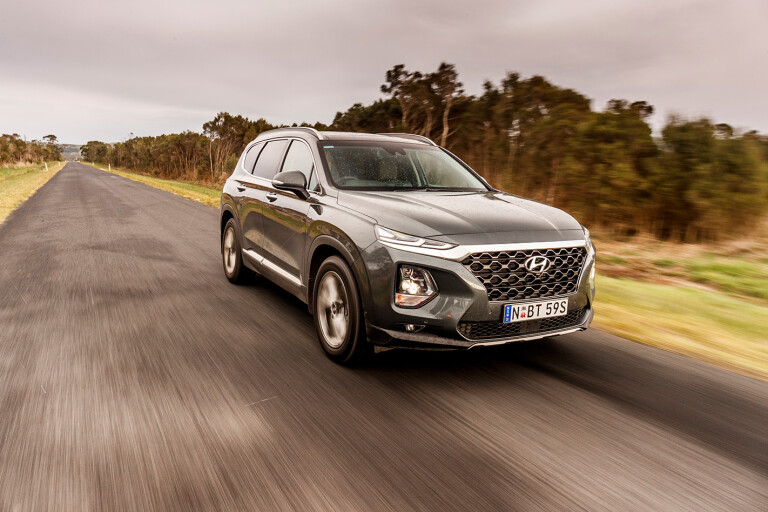
The Santa Fe, on the other hand, brings a little more scale and the result is a handsome machine inside and out, which also fulfils the role of a people mover better.
But it’s not a complete defeat by the Korean. The 5008’s smaller proportions and lower weight also bring efficiency dynamic and manoeuvring advantages over the heftier contender.
If driving dynamics, fuel efficiency and ease of use in metropolitan environments is high on the list, the Peugeot offers an accomplished high-rider wrapped up in beautiful packaging.
But if long-distance touring over changing terrain and hauling more than five people is a regular occurrence then the Hyundai is the one for you.
Critically though, both brands seem to be taking notes from each other’s strongest features and that’s good news for the whole segment and consumers alike.


COMMENTS